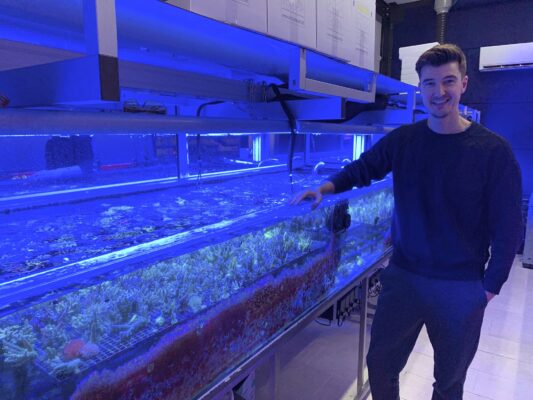Who is Leonardo?
Leonardo’s Reef was founded in 2009 by Leonardo den Breejen, and gradually specialized in the propagation of corals from the Acropora genus.
Leonardo, better known as “Leonardo’s Reef” online, has been a reefkeeper for over 20 years. In this period, he gained recognition with several projects such as “Formosa Forest” and “Apogon Reef”, has been featured on boards e.g. Reefcentral and Thereeftank, websites e.g. Reefbuilders, magazines e.g. Reef Hobbyist Magazine and recently in the “Beyond the Reef” podcast and the “Rappin’ With ReefBum” podcast.
Currently, he is the head of the Leonardo’s Reef coral farm and is a University lecturer in Biology.

The ideas behind Leonardo’s Reef
Leonardo’s Reef was founded because of three important reasons.
- Declining health of coral reefs in the wild
- The large carbon footprint of imported corals
- The amount of corals that don’t survive import and/or acclimation (long-term)
They made us think about better ways to provide the hobbyists in Europe with a great variety of Acropora corals. Our answer to these issues is: locally aquacultured Acropora.
Local propagation of Acropora has more benefits than only preventing the issues mentioned above, most importantly:
- Higher survival rates of the corals in customers’ tanks
- Stable Acropora colors and growth patterns
- Healthy Acropora with a stable and healthy microbiome
- 100% pest-free corals thanks to our closed systems, strict protocols and quarantaine
Our corals
Since the founding of Leonardo’s Reef, we have avidly collected as many species, hybrids and morphs, especially Acropora. We have over 300 different species of Acropora in our collection, and it is still growing. We are passionate about this genus, from the most ordinary green Staghorn to the High-End A. speciosa, we collect them all.
We select the most interesting Acropora by hand. We browse through retail stores, wholesalers, importers and hobbyists’ tanks to pick out the most interesting gems to propagate in our systems. We aim to be a true “coral-bank” where every species and morph is available!
Research
To understand more about the physiology and reproduction cycle of Acropora corals, we are building an Acropora spawning laboratory which will be completed in 2023. In this new facility we will find ways to use sexual reproduction (also know as “coral spawning”) for propagation purposes, as well as hybridisation. Please visit our website Coralspawning.com soon for more information.
Our customers
Working with corals every day is fantastic, frustrating, exciting, and sometimes heartbreaking. But most of all, we are grateful for our customers that make it possible for us to pursue the goal to be the largest aquaculture facility in Europe for the Acropora genus.
This means we always take care of our customers, make sure that they are happy with their purchase long-term, and invest in a lasting customer relationship. If you have any questions, comments, or anything else, please contact us!
System information and parameters
Since we moved into our new facility in Almere (NL) in 2021, we had 5.000 liters of systems to propagate Acropora, in the summer of 2023 we expanded the farm to 10.000 liters in total.
We use a combination of T5 and LED lighting in the form of ATI Hybrid fixtures, Ecotech Radion G6 and Orphek OR3 bars.
We keep maintenance as simple as possible. We strictly use Tropic Marin products and salts, mainly Pro Reef Salt, Full-Balling elements, A- and K+ trace elements and Iodine. ICPMS is done monthly. No other “methods” or additives are used.
We keep parameters as follows: we keep water parameters close to natural seawater (NSW), so the transition to our customers’ systems will most likely be minimal. Even if they don’t match exactly, it’s not a big issue. The corals can and will adapt, as they did in our husbandry for a long time. Stability is much more important.
- Photosynthetically active radiation (PAR) levels range between 250 μmol·s−1 and 500 μmol·s−1 depending on corals species.
- Temperature: 24,0 – 26,5 C
- DKH : 7.7-8.3
- Calcium : 430 – 450 ppm
- Magnesium : 1350-1450 ppm
- Nitrate : 1-5 ppm
- Phosphate : 0.05-0,06 ppm
- pH : low point above 8,1, average 8.3
Listen to the “Beyond the Reef” podcast, or the “Reefbum” podcast to learn more about our system and methods.
How do we make our product photos and videos?
At Leonardo’s Reef, we are dedicated to ensuring your complete satisfaction with our products. To provide you with the most accurate representation of our corals, we employ a meticulous approach to photography. We use a combination of T5 and LED lighting with a 14,000 Kelvin light temperature to capture the images of our corals. We never resort to using filters or extensive photo editing software in the process. However, it’s important to note that the appearance of the corals in your aquarium may differ from the images on our website. This variance can be attributed to individual differences in lighting settings, but even screen settings on your device may cause a slight difference, which can affect the colors and overall appearance of corals in your specific environment.
We encourage you to consider the images as a reference point and understand that there might be slight variations in color, brightness, and overall appearance based on your unique conditions and settings.
If you have any questions or concerns about the appearance of our corals in your aquarium or any other question, please do not hesitate to contact us. We are here to assist you and provide guidance to ensure your Acropora thrive in their new home!


